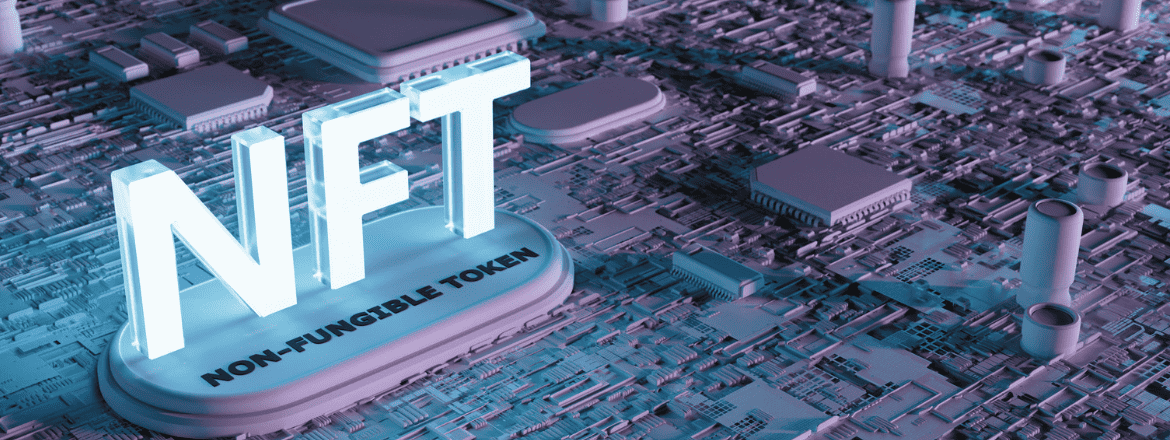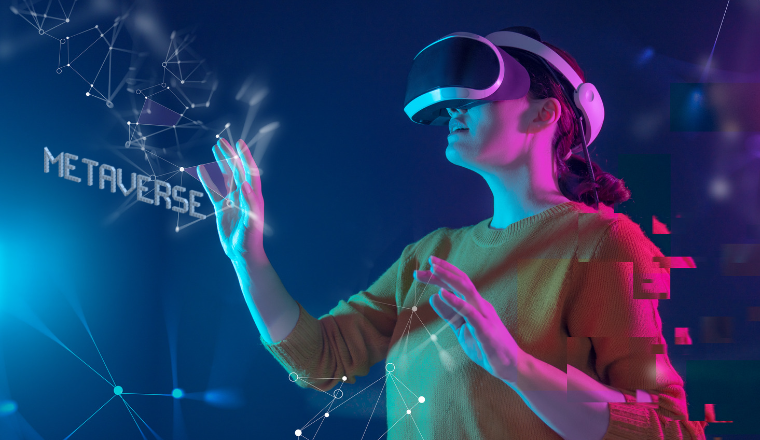Intellectual Property and NFTs and Business in the Metaverse

Table of Contents
Decoding the Synergy: NFTs, Intellectual Property, and Business in the Metaverse
The metaverse is an immersive virtual world that has been gaining momentum as the next frontier of the internet. With the emergence of new technologies such as blockchain and NFTs, the metaverse has gained a new level of prominence as it offers a unique platform for users to trade and own digital assets. As such, many intellectual property (IP) issues have arisen (or will arise) in connection with the metaverse, making it an important consideration for businesses in their market strategy. Within this dynamic environment, traditional concepts of ownership, authenticity, and value are being redefined by the innovative synergy of NFTs and IP. In this blog, we provide an insight into what the metaverse is, its connection to emerging technologies such as blockchain and NFTs, and why they are relevant for businesses' IP strategies so they can thrive in this exciting new frontier.
The Metaverse and Business: Embracing the Boundless Potential
The metaverse can be described as an immersive and persistent virtual 3D world where individuals interact through personalized avatars. The metaverse presents unparalleled opportunities for businesses, offering immersive 3D experiences and seamless transitions between physical and virtual worlds. By leveraging augmented reality and virtual reality strategically, companies can engage customers and create innovative brand experiences while reaping the benefits of cost savings and improved employee retention. According to a recent report by McKinsey & Company, the metaverse is projected to generate a staggering $5 trillion in value by 2030.
This realization has sparked the active pursuit of metaverse opportunities by countries and businesses worldwide. Dubai serves as a prominent example, unveiling its Metaverse Strategy in July 2022 with ambitions to become a global metaverse hub and one of the top 10 metaverse economies. Leading the way, Dubai established the Virtual Assets Regulatory Authority (VARA), boldly becoming the world's first regulatory authority to venture into the metaverse realm, thereby unlocking its immense potential.
The metaverse presents unparalleled opportunities for businesses, offering immersive 3D experiences and seamless transitions between physical and virtual worlds.
Unleashing the Metaverse: Harnessing the Power of NFTs as Building Blocks
The skyrocketing commercial value of NFTs is captivating the business world at an astonishing pace. It is estimated that the global NFT market size will grow from USD 3.0 billion in 2022 to USD 13.6 billion by 2027, at a Compound Annual Growth Rate (CAGR) of 35.0% from 2022 to 2027. The impact of NFTs is not limited to the realm of digital art, as they are now permeating various applications and industries. High-end fashion houses have embraced NFTs, venturing into the market by offering "digital fashion" items and even physical versions of these digital creations. Meanwhile, the events and ticketing industry, plagued by forgeries and fraud, is employing NFTs to combat black markets, scalpers, and ticket scams. Beyond that, numerous brands are seizing the potential of blockchain technology to establish foolproof authentication systems for their customers. Luxury brands that assign serial numbers to their products are harnessing the power of NFTs to authenticate unique pieces and combat the proliferation of counterfeit goods—a vital concern for trademark owners.
Additionally, companies are venturing into the release of NFT packages that include brand licenses, opening up new revenue streams and significantly boosting brand visibility. Musicians, for instance, are increasingly licensing their trademarks alongside the exclusive release of digital content tailored for their ardent fans. Integrating NFTs is reshaping the business landscape, revolutionizing revenue generation, brand protection, and fan engagement.
NFT stands for non-fungible token and can be described as a unique digital asset powered by blockchain technology. Each NFT possesses unique metadata that distinguishes it from other tokens, making it genuinely one-of-a-kind and easily verifiable. By virtue of these distinguishing characteristics, NFTs are proof of ownership and authenticity for underlying assets. Within the metaverse, NFTs play a pivotal role, providing users with a means to engage in the purchase, sale, and exchange of one-of-a-kind underlying assets. These assets encompass a diverse array of items, including avatar clothing and accessories, virtual real estate, gaming items, and artwork, among others. The significance of NFTs within the metaverse stems from their ability to offer users a secure and transparent mechanism to establish ownership and verify the authenticity of their assets. The utilization of blockchain technology as the foundation of NFTs ensures the creation of a permanent and unalterable record of ownership, effectively addressing concerns related to counterfeiting and unauthorized replication.
Unveiling the Intersection of NFTs and Intellectual Property: Navigating Key Considerations and Latest Updates.
Just as intellectual property (IP) carries weight in the physical world, its significance remains unchanged in the metaverse. However, its importance in this virtual realm may even be heightened! The metaverse unveils profound and pressing questions regarding the protection of IP assets and the level of authority that IP owners can wield over these assets. Moreover, a daunting concern emerges, questioning the implications of utilizing third-party IP without proper authorization, potentially resulting in potential infringement.
In the following, we will consider how IP rights interplay with NFTs, specifically the areas of copyright and trademarks.
To explore the intricate relationship between IP rights and NFTs, it is crucial to grasp the three fundamental elements that constitute an NFT: unique metadata, associated digital creative content, and the underlying smart contract. NFTs have the ability to encompass diverse forms of creative output, like a piece of art, a song, videos, collectibles, etc. However, there exists a common misconception that an NFT's non-fungibility and distinctiveness solely stem from its associated creative output.
In reality, the true essence of an NFT's non-fungibility resides in its unique metadata, specifically, its unique identifier recorded on the distributed ledger (DL). To shed light on this concept, let us draw a parallel to the world of fine art. Imagine an NFT as a digital certificate of authenticity for a digital asset, akin to how an artist's signature signifies the provenance of a painting.


NFTs and Copyright
The creative output, such as artwork, literature, and music, associated with an NFT can be eligible to be protected by copyright if it fulfills the established requirements, e.g., originality and creativity. It is possible for copyright to also cover the metadata and smart contract code of an NFT, although this aspect has not been extensively tested in legal cases.
From a copyright perspective, one of the key issues that cause confusion is whether the purchaser of an NFT automatically gains ownership of the copyright of the associated creative output. This question carries significant importance, especially given the substantial monetary value that NFTs can attain. The answer to this question depends on the specific provisions included in the smart contract governing the purchased NFT. In most commonly used smart contracts, the acquisition of an NFT does not inherently transfer the copyrights attached to its creative output.
Therefore, when a buyer purchases an NFT based on a copyrighted work, it is essential to ensure the transfer of copyright ownership by explicitly including a written assignment of the copyright within the smart contract or documenting it separately through a deed of assignment outside the smart contract. By doing so, the buyer can establish a legitimate claim to the copyright and avoid potential copyright infringement issues.
For more details, read our in-depth article on NFTs and Copyrights.
NFTs and Trademarks
The rising popularity and significance of the metaverse and NFTs have spurred a notable surge in businesses seeking trademarks associated with NFTs. In 2022, the U.S. Patent and Trademark Office (USPTO) received 5,800 trademark applications specifically related to NFTs and their accompanying technology. This figure more than doubled the previous year's count of 2,087 applications in 2021. Trademark classes 9, 35, and 41 emerged as the most utilized classes for these trademark filings.
An NFT can be shaped as everything from symbols and pictures to signs and drawings and can look like figures, pieces of clothing, works of art, etc. The distinctive shape of NFTs can be protected as a trademark. In this context, and recognizing the need for proper classification for NFTs, virtual goods, and services within the metaverse, regulatory bodies such as the European Union Intellectual Property Office (EUIPO), the USPTO, and the UK Intellectual Property Office (UKIPO) have issued comprehensive guidelines. These guidelines provide practical insights and guidance for classification, ensuring clarity and effective protection of trademarks in this dynamic virtual landscape.
Furthermore, on January 1, 2023, the 12th edition of the new version of the Nice Classification came into force, ushering in updated categories for the registration of trademarks in relation to NFTs. This revised edition is being embraced and implemented by various national trademark offices, including the EUIPO and IP Australia. Notably, Class 9 now encompasses a new item entitled "downloadable digital files authenticated by non-fungible tokens." The incorporation of this edition reflects the evolving landscape and the mounting prevalence of trademarks related to NFTs and the metaverse.
On the other hand, metaverse users must be mindful not to incorporate third-party trademarks into NFTs without proper consent, as this could expose them to the danger of trademark infringement. Two landmark cases, capturing global attention, have emerged to provide clarity on how trademark law applies to NFTs.
In the first case, Mason Rothschild's 'Metabirkins' NFTs incorporated the Hermès registered trademark and replicated the distinctive design of their renowned handbags without obtaining proper consent. Consequently, a New York court held Rothschild accountable for trademark infringement. Similarly, in the Court of Rome, Juventus FC successfully obtained a trademark infringement ruling against NFT producer Blockeras. The Blockeras NFTs prominently featured the word marks 'Juventus' and 'Juve,' along with the design of the club's iconic black and white jersey. The Rome Court of First Instance determined that the minting, advertising, and sale of these NFTs without authorization violated Juventus' trademark rights.
Conclusion
In conclusion, the metaverse's emergence as the next frontier of the internet has propelled it into the spotlight, thanks to the integration of technologies like blockchain and NFTs. As businesses explore the vast opportunities within the metaverse, it becomes imperative to consider intellectual property (IP) strategies to navigate the associated challenges. By embracing the immersive and interactive nature of the metaverse, companies can create unique brand experiences and engage customers in unprecedented ways. However, protecting IP assets in this virtual realm and avoiding IP infringement is crucial, and businesses must prioritize proper compliance with IP laws.
As the metaverse continues to evolve, businesses that adapt and integrate robust IP strategies will be well-positioned to thrive in this exciting new frontier, harnessing its limitless potential while safeguarding their own IP rights and respecting the rights of others. By understanding the intricacies of the metaverse, staying updated on IP regulations, and actively protecting their IP assets, businesses can establish a strong foundation for success in this rapidly expanding virtual realm.
Frequently Asked Questions
What is the Metaverse?
The Metaverse is an immersive virtual world where users interact through personalized avatars, offering opportunities for businesses in augmented and virtual reality. It's projected to generate $5 trillion in value by 2030.
What is the significance of NFTs in the Metaverse?
NFTs (Non-Fungible Tokens) play a crucial role in the Metaverse by providing a secure and transparent mechanism for users to establish ownership and verify the authenticity of digital assets.
What is the current market size of the global NFT market?
The global NFT market size is estimated to grow from USD 3.0 billion in 2022 to USD 13.6 billion by 2027, indicating a CAGR of 35.0% from 2022 to 2027.
How does blockchain technology contribute to NFTs' significance?
Blockchain technology ensures the uniqueness and authenticity of NFTs by providing a permanent and unalterable record of ownership, addressing concerns related to counterfeiting.
What intellectual property considerations arise in the Metaverse?
Intellectual property (IP) considerations in the Metaverse include questions about the protection of IP assets, authority over these assets, and potential infringement when utilizing third-party IP without proper authorization.
How do copyright and trademarks interplay with NFTs?
Copyright can protect the creative output associated with an NFT, while trademarks are relevant for the distinctive shape of NFTs. The purchaser of an NFT does not automatically gain ownership of the copyright, depending on the smart contract provisions.
What is the significance of trademarks in the Metaverse?
Trademarks play a crucial role in the Metaverse, with businesses seeking trademarks associated with NFTs. Guidelines have been issued for effective classification and protection of trademarks in this dynamic virtual landscape.
What recent changes have occurred in trademark classification related to NFTs?
The 12th edition of the Nice Classification, implemented in 2023, includes a new item in Class 9: "downloadable digital files authenticated by non-fungible tokens," reflecting the evolving landscape of trademarks in the Metaverse.
Can incorporating third-party trademarks into NFTs lead to legal consequences?
Yes, incorporating third-party trademarks into NFTs without proper consent can lead to legal consequences, as seen in cases where NFT producers faced trademark infringement rulings for unauthorized use of registered trademarks.
How can businesses protect their intellectual property in the Metaverse?
Businesses can protect their intellectual property in the Metaverse by adapting robust IP strategies, staying updated on IP regulations, and ensuring proper compliance with IP laws to establish a strong foundation for success.






